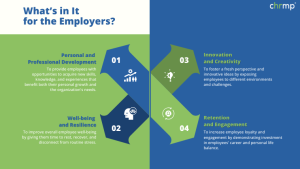Sometimes, the relentless pace of work, combined with life’s various demands, necessitates a meaningful pause. A sabbatical leave, ranging from a month to a year, offers an exceptional opportunity for employees to pursue passions or personal development, acting like a mini-retirement with the assurance of returning to your career.
Thank you for reading this post, don't forget to subscribe!In a professional landscape where burnout is increasingly common, sabbatical leaves serve as a strategic respite, offering employees a significant break to rejuvenate and pursue personal and professional development. This extended time away from daily work duties is not just a mere leave but a growth-centric break designed to benefit both the employee and the organization.
Table of Contents
ToggleWhat is Sabbatical Leave?
A sabbatical leave is a break from work, allowing employees to engage in activities for personal or professional growth. It’s a period for reassessment and rejuvenation, ensuring individuals return to work refreshed and more productive.
Sabbatical leave provides a structured opportunity for employees to step back from their daily responsibilities to engage in varied activities that promote personal enrichment and professional growth. This period can range from a few months to a year and is often seen as a mini-retirement with the security of returning to one’s position.
Overview of Sabbatical Leave: History, Trends, and Current Relevance
Sabbatical leave has its roots in academia, where it has been used as a means for faculty to pursue research and personal development without teaching obligations. Historically, this practice dates back to the late 19th century but has since permeated various sectors, recognizing the value of long-term leave for professional growth and organizational vitality.
The trend has gained momentum in the corporate world as companies recognize the benefits of allowing employees extended breaks to rejuvenate and pursue personal interests or further education. Today, sabbatical leave is relevant as organizations strive to boost employee satisfaction, enhance retention, and cultivate a supportive workplace culture.
Exploring the Core Benefits of Sabbatical Leave for Employees:
- Recharging and Renewing Energy: Sabbatical leave provides a crucial break from daily routines, allowing employees to destress and recharge, fostering increased motivation and productivity upon their return.
- Gaining New Skills and Knowledge: The break enables employees to pursue educational opportunities, such as workshops or classes, enhancing their skills and bringing valuable insights back to their roles.
- Improving mental and physical health: Stepping away from the workplace can significantly boost both mental and physical well-being, reducing burnout and promoting overall health.
- Building Better Work-Life Balance: Sabbaticals help employees achieve a more sustainable balance between their personal lives and careers, enhancing job satisfaction and employee retention.
- Developing New Perspectives: Exposure to new cultures and ideas during a sabbatical can inspire innovative thinking and creative problem-solving skills.
- Networking Opportunities: Time away from the usual work environment allows for meeting new people and expanding professional networks, which can open up new career opportunities.
- Increased Job Satisfaction and Productivity: The break can lead to higher job satisfaction, as employees feel valued and return to their jobs with renewed enthusiasm and ideas.
What’s in it for the employers?
Organizations also gain from implementing sabbatical policies. Employees return more engaged and revitalized, often bringing innovative ideas that enhance productivity. Moreover, sabbaticals serve as a powerful tool for employee retention and can significantly enhance employer branding by showcasing commitment to employee development.

- Personal and Professional Development: To provide employees with opportunities to acquire new skills, knowledge, and experiences that benefit both their personal growth and the organization’s needs.
- Well-being and Resilience: To improve overall employee well-being by giving them time to rest, recover, and disconnect from routine stress.
- Innovation and Creativity: To foster a fresh perspective and innovative ideas by exposing employees to different environments and challenges.
- Retention and Engagement: To increase employee loyalty and engagement by demonstrating investment in employees’ career and personal life balance.

Sabbatical vs. Vacation.
While both sabbaticals and vacations offer a break from work, their purposes, structures, and outcomes differ significantly:
Purpose: Vacations are meant for short-term relaxation and recreation, typically lasting from a few days to a few weeks. Sabbaticals are longer-term breaks that focus on personal and professional development.
Duration and Planning: Vacations are brief and require minimal planning regarding workload coverage. Sabbaticals, being extensive, necessitate strategic planning to cover the employee’s responsibilities during their absence.
Impact: The return from a vacation is often marked by a temporary boost in energy, while a sabbatical aims for profound, sustainable impacts on an employee’s career and personal life, including increased creativity, renewed motivation, and often, new skills.
Compensation: Vacations are generally paid leaves, whereas sabbaticals may have varied compensation policies, often dependent on company policy and the goals of the sabbatical.
Implementing and Managing Sabbatical Leave
Successful implementation of a sabbatical program involves several critical steps:
- Policy Development: Clearly define the criteria for eligibility, duration, compensation, and the application process. Policies should be transparent, equitable, and aligned with organizational goals.
- Budget Planning: Assess the financial implications of offering sabbaticals, including direct costs like salary and indirect costs such as temporary staff or overtime for existing employees.
- Resource Allocation: Plan how to allocate human resources in the absence of the sabbatical-taking employee. This might involve temporary promotions, redistributing tasks, or hiring interim staff
How Does Sabbatical Leave Work?
Understanding the process of applying for and taking a sabbatical leave is crucial for both employees and employers. Here’s a structured breakdown of the typical steps involved in a sabbatical leave program:
Requesting a Sabbatical
An employee initiates a sabbatical by submitting an application for sabbatical leave. This proposal should outline the intended duration of the sabbatical period, the activities planned during the break, and a detailed plan for transitioning work responsibilities to colleagues. This ensures continuity and prepares the team for the employee’s temporary absence.
Approval Process
Upon receiving the sabbatical application, employers review the feasibility and alignment of the proposed sabbatical with organizational goals. This stage may involve discussions and modifications to the sabbatical leave proposal to meet both the employee’s and the organization’s needs. The employer’s decision to approve, modify, or deny the sabbatical leave request is crucial, as it sets the stage for planning and execution.
Planning
Effective planning is essential for a successful sabbatical. This step includes detailed arrangements on how the employee’s responsibilities will be managed during their absence. It often involves redistributing tasks among team members or arranging temporary cover, which helps maintain productivity and ensure smooth operations.
Taking the Sabbatical
During the sabbatical break, the employee engages in the activities outlined in their sabbatical proposal. Whether it’s for professional development, research, or personal growth, this period allows the employee to focus fully on their sabbatical objectives without the day-to-day demands of their job.
Returning to Work
Upon returning from the sabbatical, the employee is often expected to share the knowledge, skills, and experiences gained with their team and integrate these learnings into their work. This phase is crucial for leveraging the sabbatical’s benefits both for the individual and the organization, enhancing job satisfaction and contributing to professional development.
It’s important to note that sabbatical policies and the specifics of how a sabbatical is implemented can vary widely among organizations. Not all companies offer sabbatical leaves, and the sabbatical leave rules, including eligibility and procedures, can differ. Employees interested in taking a sabbatical should consult their HR department to understand the specific sabbatical leave policy and sabbatical leave rules applicable within their organization

Developing a Sabbatical Leave Policy
A comprehensive sabbatical leave policy is crucial for ensuring that the program is beneficial and sustainable.
Creating an effective sabbatical policy involves defining objectives, determining eligibility, setting the duration, deciding on compensation, and outlining the application and approval processes.
Communication of the policy is crucial to ensuring all employees understand how they can benefit and what is expected of them.
Here’s a step-by-step guide based on best practices:
Policy Statement and Purpose:
The policy should begin with a clear statement of support for employees’ growth and well-being, outlining the intent to provide opportunities for significant professional and personal development.
Scope and Eligibility:
Define who qualifies for sabbatical leave, typically employees with a specified period of continuous service (e.g., five years). Clarify any stipulations such as the requirement to remain with the company for a certain period post-sabbatical to benefit from the policy fully.
Application and Approval Process:
Detail the application procedure, which should include a proposal from the employee outlining the purpose and timeline of the sabbatical. The approval process must involve both the direct manager and HR to ensure that all operational aspects are covered.
Sabbatical Compensation:
Clearly outline the compensation during the sabbatical, which might be a percentage of the salary (e.g., 30% of CTC) and mention the continuation of benefits during the leave period.
Work Coverage Plan:
Develop strategies for handling the employee’s duties in their absence. This might include temporary redistribution of tasks or hiring interim staff.
Reintegration Plan:
Plan for the employee’s return to work, ensuring they can reintegrate smoothly and apply any new skills or insights gained.
Communication and regular updates:
Ensure the policy is communicated clearly to all employees and regularly reviewed and updated to reflect any organizational changes or feedback.
Financial Aspects: Compensation During Sabbatical Leave
The approach to compensation during sabbatical leave varies significantly among organizations and is reflective of their strategic priorities and financial capabilities. Understanding the compensation structure is crucial for both employers and employees considering a sabbatical.
Fully Paid Sabbaticals: Some companies view offering full pay during sabbaticals as a strategic investment in their workforce’s well-being and long-term productivity. This is often utilized to retain top talent and encourage a deep-seated commitment to the organization. For instance, tech companies may provide fully paid sabbaticals post significant career milestones to foster innovative thinking and professional rejuvenation.
Partially Paid Sabbaticals: It is more common for organizations to offer partial compensation during a sabbatical, which helps balance financial sustainability with employee support. This model typically provides 50-75% of the usual salary and might link the level of compensation to the duration of the sabbatical or the nature of the activities undertaken, such as professional development or volunteer efforts.
Unpaid Sabbaticals: Particularly within smaller companies or during tighter economic conditions, sabbaticals may be offered without pay but with the assurance of job security upon return. These arrangements often allow employees to maintain their benefits, albeit potentially at their own expense, ensuring they still have support despite the lack of a salary.
Are Employees Paid During a Sabbatical?
The specifics of payment during a sabbatical can depend greatly on company policy and the terms of the sabbatical leave program. While some employers offer full salary during the leave, others may opt for reduced pay or no compensation. Employees might also be required to utilize accrued vacation or sick leave during their sabbatical.
In certain scenarios, employees may be eligible to combine their sabbatical with legally protected leaves, such as the Family and Medical Leave Act (FMLA) or even short-term disability, depending on the circumstances of their sabbatical. Alternately, some might negotiate part-time work or consulting arrangements that allow them to earn while on leave.
Moreover, many individuals choose to use their sabbatical for volunteer work or other unpaid opportunities, prioritizing personal growth or community contribution over financial gain during their break. As sabbatical policies vary widely, it is essential for employees to consult their HR department or refer to their organization’s sabbatical leave policy to understand the specifics of compensation and other logistical details.
Communication Strategies to Manage Workforce During Absences
Effective communication is essential to managing the gaps in your team when an employee takes a sabbatical. Here’s how you can maintain smooth operations and transparency during such periods:
Pre-Sabbatical Planning: Before their leave, collaborate closely with the departing employees to thoroughly understand and document their responsibilities. This ensures a seamless transition and minimizes disruptions to daily operations. Establishing a detailed plan for their duties is key to a successful sabbatical period.
Continuous Updates: Keep the lines of communication open with employees on sabbatical, when appropriate. Regular updates can help manage expectations and prepare for their return. It’s also crucial to keep the rest of the team informed about the sabbatical taker’s status, fostering a sense of continuity and team cohesion.
Transparency with Clients and Stakeholders: Proactively communicate any changes in personnel to clients and stakeholders to assure them of uninterrupted service quality. Ensuring that they are informed about who will be handling responsibilities in the interim helps maintain trust and confidence in your organizational reliability.
These strategies not only help bridge the gap during a sabbatical but also strengthen your team dynamics and client relationships, crucial aspects of a robust sabbatical leave policy. Implementing these communication practices ensures that both the sabbatical leave process and overall business operations run smoothly, reflecting well on your organization’s management and operational excellence.

Monitoring and Evaluating the Impact of Sabbaticals
To effectively measure the success and areas for improvement of sabbatical programs, it’s crucial for organizations to implement a comprehensive evaluation strategy. Here’s how to ensure your sabbatical policies are delivering their intended benefits:
Feedback Collection:Regularly solicit feedback from employees who have taken sabbaticals, as well as their peers, to understand the program’s impact on their professional growth and team dynamics. This feedback is invaluable for gauging the personal and collective benefits of sabbaticals and for identifying opportunities to enhance the experience.
Performance Metrics:Conduct thorough analyses of productivity metrics before, during, and after sabbaticals. This data helps to understand how well the team adapts to absences and continues to meet organizational goals. It also highlights the effectiveness of interim solutions put in place to cover for the sabbatical-taking employee.
Program Adjustments: Leverage the insights obtained from feedback and performance evaluations to continuously refine and optimize your sabbatical policies. Making informed adjustments ensures that the program remains aligned with organizational objectives and employee needs, enhancing overall satisfaction and effectiveness.
By systematically monitoring and evaluating the impact of sabbatical leaves, organizations can ensure these programs contribute positively to employee well-being and organizational productivity, ultimately supporting a strong sabbatical leave policy.
Return from Sabbatical: Effective Integration Strategies for Returning Employees
Ensuring a smooth transition back to work for employees returning from sabbatical is crucial for maximizing the benefits of their time away. Here are some effective strategies to facilitate this reintegration:
Welcome Back Session: Conduct a structured welcome back session to brief the returning employee on any significant changes and developments that occurred during their absence. This session helps to quickly acclimate them to the new environment and updates, ensuring they feel connected and informed.
Mentorship Programs: Pair the returning employee with a mentor who can provide guidance and support as they readjust to their workplace role. This mentorship can be invaluable in helping them navigate any new processes, technologies, or shifts in team dynamics that may have taken place.
Gradual Work Reintroduction:Implement a phased approach to reintegrate returning employees into their full duties. Starting with a lighter workload or flexible hours can help ease the transition, allowing them to adjust more comfortably and effectively to the demands of their role.
By adopting these strategies, organizations can help returning employees leverage their sabbatical experiences to enhance their contributions and re-engage with their work with renewed energy and perspectives. This approach not only benefits the individual but also enriches the team and the broader organizational culture.
Capturing and Leveraging Learning from Sabbatical Experiences
Organizations have the opportunity to maximize the benefits of sabbatical programs by implementing the following strategies:
Debrief Sessions: Organize comprehensive debrief sessions where employees returning from sabbaticals can present their learnings and experiences. This allows the returnee to share new knowledge and ideas that could potentially benefit their teams and the organization as a whole.
Knowledge Sharing:Integrate the valuable insights and knowledge gained during sabbaticals into existing training modules or into the development of new projects and strategies. This ensures that the broader organization benefits from the diverse experiences of its employees, fostering a culture of continuous learning and innovation.
Documentation: Maintain detailed records of sabbatical case studies and gather testimonials from employees who have participated in the program. This documentation serves to validate the value of the sabbatical program and enhances its credibility and appeal to current and future employees. It also provides a rich resource for reviewing the effectiveness of the program and making necessary adjustments.
By strategically utilizing these methods, organizations can strengthen the impact of their sabbatical programs, contributing to a more dynamic, informed, and motivated workforce.
Conducting a Cost-Benefit Analysis for Sabbatical Programs
A thorough cost-benefit analysis of sabbatical programs is crucial for organizations to understand their value. Here’s how to approach it:
Direct Costs: Begin by calculating the direct financial costs associated with the sabbatical. This includes continued salary payments to the employee on sabbatical and the costs related to hiring temporary staff or paying overtime to existing employees to cover the absent employee’s duties.
Indirect Benefits: Evaluate the intangible benefits that a sabbatical program can bring. These benefits often include improved employee morale, enhanced capacity for innovation, and increased productivity post-sabbatical. Although these benefits might not be immediately quantifiable, they play a significant role in the long-term success and competitive edge of the organization.
By systematically analyzing both the costs and benefits, organizations can make informed decisions about implementing or continuing sabbatical programs, ensuring that they contribute positively to the company’s goals and employee satisfaction
Real-World Examples: Global Companies with Successful Sabbatical Programs
Many leading organizations recognize the value of providing sabbatical leave as a significant benefit to their employees, enhancing job satisfaction and employee retention. Here are some notable examples:
Google: Known for its innovative HR practices, Google offers up to six months of sabbatical leave with full pay. Additionally, Google has implemented a comprehensive re-entry program designed to help employees transition smoothly back into their work roles after their sabbatical, ensuring they can reintegrate with ease and continue to contribute effectively.
Patagonia: Offers up to two months of paid leave for employees to engage in volunteer environmental work, aligning with its corporate values and mission.
Netflix: At Netflix, the sabbatical is referred to as a ‘leave of absence.’ Employees are eligible to take up to one year off with full pay and benefits, reflecting the company’s commitment to employee well-being and its understanding of the need for extended breaks for personal development or rest.
LinkedIn: LinkedIn provides a six-month fully paid sabbatical, which employees can take advantage of at any point during their tenure. This flexibility allows employees to plan for significant life events or personal growth opportunities without financial stress.
Sabbaticals in Non-profits: Organizations like the Skoll Foundation provide sabbaticals for social entrepreneurs to innovate and reflect, enhancing their impact on societal challenges.
It’s important to note that the specifics of sabbatical leave policies, including duration, compensation, and eligibility criteria, may vary across different departments and geographical locations within the same company. Employees interested in taking a sabbatical should consult with their HR department or direct supervisor to understand the detailed provisions of their organization’s sabbatical leave policy.
By offering sabbatical leaves, companies like Google, Netflix, and LinkedIn not only enhance their attractiveness as employers but also invest in the long-term productivity and satisfaction of their workforce. This strategic approach to human resources helps foster a motivated, engaged, and loyal team.
Conclusion:
Sabbatical leave offers a unique opportunity for employees and employers alike, fostering professional growth, enhancing personal well-being, and ultimately contributing to a more dynamic and productive organizational culture. By strategically implementing and managing sabbatical leaves, organizations not only invest in their workforce but also enhance their competitive edge in today’s fast-paced business environment.
Frequently Asked Questions:
- Do you get paid during a sabbatical
It varies by company. Some provide full pay, others partial, and some none, depending on the sabbatical’s purpose and length.
- How long is a typical sabbatical? Duration can vary from a few months to a year, based on company policy and the objectives of the sabbatical.
- Who is eligible for a sabbatical? Eligibility criteria can include tenure, contribution to the organization, and the strategic value of the proposed sabbatical activities.
- Can you work during your sabbatical?
Company policies may vary. Some encourage volunteer work or professional development, while others may restrict any form of employment during the sabbatical.
Download your free sabbatical leave policy now and streamline your sabbatical management efforts






